| Posted: Jun 25, 2012 | |
Charging your cell phone with your T-shirt |
|
| (Nanowerk Spotlight) The future of electronics will be flexible. Not only will you be able to roll up your iPads and smart phones like a piece of paper, electronic devices will be invisibly embedded in the textiles you wear from baby diapers to doctors' surgical gloves (see our previous Nanowerk Spotlight: "Nanotechnology electronics at the tip of your gloved finger"). | |
| To realize such devices, equally flexible power sources need to be integrated with the electronic devices. Textile yarns are an obvious choice. Researchers are already pushing ahead with electronic textiles (e-textiles), for instance by coating regular cotton yarns with single-walled and multi-walled carbon nanotubes and polyelectrolytes, thus making cotton fibers conductive (see: "Nanotechnology e-textiles for biomonitoring and wearable electronics"). | |
| Addressing the power source issue, researchers have now found a simple way to provide cotton with a new function – storing energy. | |
| "Inspired by traditional activation of cellulose fibers into activated carbon fibers with a simple chemical route, we converted cotton T-shirt textiles into activated carbon textiles for energy storage applications," Xiaodong Li, CEC Distinguished Professor in the Department of Mechanical Engineering at the University of South Carolina, tells Nanowerk. "After such functionalization, the textile features were well preserved and the obtained activated carbon fibers are highly conductive and flexible, enabling an ideal electric double layer capacitor performance." | |
| Reporting their findings in the May 16, 2012 online edition of Advanced Materials ("Towards Textile Energy Storage from Cotton T-Shirts"), Li and first author Lihong Bao, a postdoctoral researcher in Li's group, demonstrate how cotton textiles can be functionalized into activated carbon textiles (ACTs) by a simple chemical activation route – a traditional dipping, drying and curing process. During this process, the cellulose fibers are converted into activated carbon fibers. | |
 |
|
| A piece of activated carbon textile under folding conditions. (Image: Drs. Bao and Li, Nanostructures and Reliability Laboratory, University of South Carolina) | |
| Li explains that the coupled superior capacitive characteristic and high porosity make the ACTs unique supporting backbones for controlled deposition of nanostructured pseudo-capacitive manganese dioxide (MnO2) to construct a hybrid composite for enhanced electrochemical performance. "The key point of the design lies in activation of cotton T-shirt textiles into porous, mechanically flexible, and highly conductive ACTs with high electrolytically accessible surface area." | |
| Performing cyclic voltammetry test, the scientists explore the electrochemical performance of their hybrid MnO2/ACT composite. "The specific capacitances calculated from the CV curves at different scan rates indicate remarkably improved capacitance performance with almost 3 times increase in specific capacitance compared to that of ACTs," says Li. "We think that the energy storage capacity can be further improved by depositing a nanometer-thick transition metal oxide film or graphene layer. This may open up a new field – biomaterial-enabled energy storage." | |
| The key finding of this work is that cheap and and environmentally friendly textiles such as cotton can be a low-cost and green solution for textile-based energy-storage devices. | |
| "Cotton is an environmentally friendly, renewable, and easily recyclable material – unlike oil and engineered chemicals" says Li. "It is a promising candidate as power source for future electronic devices." | |
| In future research, the scientists may extend their method to process other cellulosic materials such as bamboo and pine straws into activated carbon for flexible high performance supercapacitor and battery electrodes. | |
| They are also scaling up the process. "The next phase is to work with industry partners to take the concept to market" says Li. "We are also reaching out to state government leaders about using this process to help revive local cotton textile production as well as to the federal funding agencies to seek their support." | |
 By
Michael
Berger
– Michael is author of three books by the Royal Society of Chemistry:
Nano-Society: Pushing the Boundaries of Technology,
Nanotechnology: The Future is Tiny, and
Nanoengineering: The Skills and Tools Making Technology Invisible
Copyright ©
Nanowerk LLC
By
Michael
Berger
– Michael is author of three books by the Royal Society of Chemistry:
Nano-Society: Pushing the Boundaries of Technology,
Nanotechnology: The Future is Tiny, and
Nanoengineering: The Skills and Tools Making Technology Invisible
Copyright ©
Nanowerk LLC
|
|
|
Become a Spotlight guest author! Join our large and growing group of guest contributors. Have you just published a scientific paper or have other exciting developments to share with the nanotechnology community? Here is how to publish on nanowerk.com. |
|
